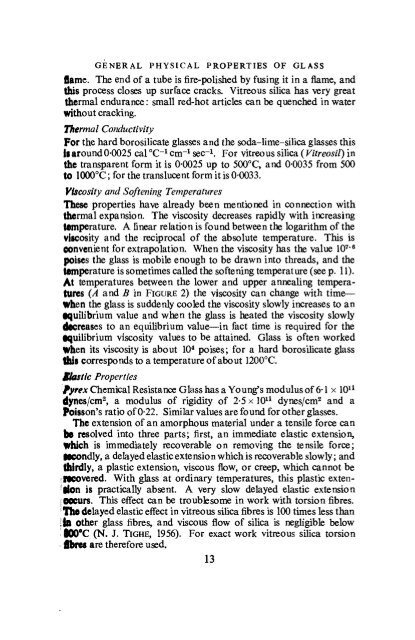Laboratory Glass-Working for Scientists - Sciencemadness Dot Org
Laboratory Glass-Working for Scientists - Sciencemadness Dot Org
Laboratory Glass-Working for Scientists - Sciencemadness Dot Org
You also want an ePaper? Increase the reach of your titles
YUMPU automatically turns print PDFs into web optimized ePapers that Google loves.
GENERAL PHYSICAL PROPERTIES OF GLASS<br />
Bamc. The end of a tube is fire-polished by fusing it in a flame, and<br />
this process closes up surface cracks. Vitreous silica has very great<br />
thermal endurance: small red-hot articles can be quenched in water<br />
without cracking.<br />
Thermal Conductivity<br />
For the hard borosilicate glasses and the soda-lime-silica glasses this<br />
ft around 0-0025 cal °C" 1 cm -1 sec 1 . For vitreous silica ( Vitreosil) in<br />
the transparent <strong>for</strong>m it is 0-0025 up to 500°C, and 0-0035 from 500<br />
to 1000°C; <strong>for</strong> the translucent <strong>for</strong>m it is 0-0033.<br />
Viscosity and Softening Temperatures<br />
These properties have already been mentioned in connection with<br />
thermal expansion. The viscosity decreases rapidly with increasing<br />
temperature. A linear relation is found between the logarithm of the<br />
viscosity and the reciprocal of the absolute temperature. This is<br />
Convenient <strong>for</strong> extrapolation. When the viscosity has the value 10 7 " 6<br />
poises the glass is mobile enough to be drawn into threads, and the<br />
temperature is sometimes called the softening temperature (see p. 11).<br />
At temperatures between the lower and upper annealing temperatures<br />
(A and B in FIGURE 2) the viscosity can change with time-<br />
When the glass is suddenly cooled the viscosity slowly increases to an<br />
•quilibrium value and when the glass is heated the viscosity slowly<br />
decreases to an equilibrium value—in fact time is required <strong>for</strong> the<br />
•quilibrium viscosity values to be attained. <strong>Glass</strong> is often worked<br />
When its viscosity is about 10 4 poises; <strong>for</strong> a hard borosilicate glass<br />
this corresponds to a temperature of about 1200°C.<br />
Elastic Properties<br />
fyrex Chemical Resistance <strong>Glass</strong> has a Young's modulus of 6-1 x 10 n<br />
iynes/cm 2 , a modulus of rigidity of 2-5 x 10 11 dynes/cm 2 and a<br />
Poisson's ratio of 0-22. Similar values are found <strong>for</strong> other glasses.<br />
The extension of an amorphous material under a tensile <strong>for</strong>ce can<br />
be resolved into three parts; first, an immediate elastic extension,<br />
Which is immediately recoverable on removing the tensile <strong>for</strong>ce;<br />
lecondly, a delayed elastic extension which is recoverable slowly; and<br />
thirdly, a plastic extension, viscous flow, or creep, which cannot be<br />
recovered. With glass at ordinary temperatures, this plastic extentlon<br />
is practically absent. A very slow delayed elastic extension<br />
occurs. This effect can be troublesome in work with torsion fibres.<br />
The delayed elastic effect in vitreous silica fibres is 100 times less than<br />
to Other glass fibres, and visa) us flow of silica is negligible below<br />
100*C (N. J. TIGHE, 1956). For exact work vitreous silica torsion<br />
fbres are there<strong>for</strong>e used.<br />
13
















